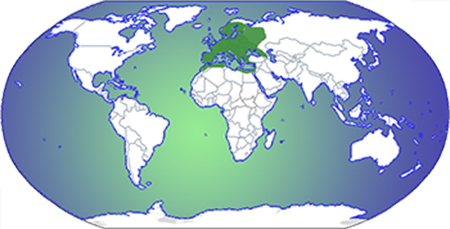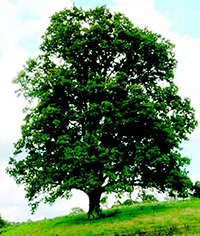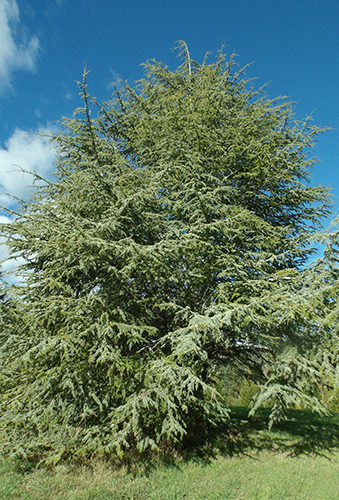forests follow retreat of ice
Overview
Millions of years ago, as the continental plates drifted, the orientation and shape of Europe changed repeatedly. Following the last of a series of ice ages about 10,000 years ago, the continuous ice sheet began to retreat northward as the climate warmed, and the seeds of trees that had survived further south began to establish themselves.
While Britain, Ireland and France were connected by land, plants and animals could spread readily. As the ice melted, water covered the lower-lying land, cutting Britain off from continental Europe.
Nowadays the effects of climate change and human activity can be seen across Europe. The far north has very few trees. Northern forests are dominated by conifers, such as spruce and pines, and the middle latitudes by broad-leaved trees such as oak, beech, ash and elm.
In the south and around the Mediterranean, it is warmer and drier and drought-resistant species like the olive (Olea) and date palm (Pheonix dactylifera) predominate.
»Follow this link to view a map with the locations of the collection highlighted.

Mythology and Folklore

of the Common or English Oak (Quercus robur)
Throughout European history the oak tree has been held in high regard. The Druids frequently worshipped and practised their rites in oak groves, and the Greeks, Romans, Celts, Slavs and Norse tribes each associated the oak with their own supreme god.
Ancient kings presented themselves as the personifications of these gods, taking on responsibility for success in battle and for the fertility of the land. They wore crowns of oak leaves, symbolising the gods they represented. Later, successful Roman commanders were presented with crowns of oak leaves, and today oak leaves continue as decorative icons of military prowess.
The spiritual appreciation of oak did not cease with the advent of Christianity, although many oak groves were supplanted by early Christian churches.
In Somerset stand the two very ancient oaks Gog and Magog (named after the last two of the mythological giants said to have once roamed Britain), which are reputed to be the remnants of an oak-lined processional route up to nearby Glastonbury Tor.
The Major oak in Sherwood Forest is purported to be the tree where Robin Hood and his Merry Men hatched their plots, and is now a popular tourist attraction (though this particular tree probably does not predate the 16th century).
The Traditional European Christmas Tree
The Norway spruce (Picea abies) is an important timber tree, sometimes called Deal or Whitewood, and is spread through most of northern Europe (excluding Britain) from the Pyrenees through the Alps and Carpathian Mountains to western Russia.
The spruces are distinguished by their long hanging cones with thin scales and needles carried on short peg-like projections. They are an evergreen, spring-flowering conifer, growing in forests or plantations to a height of 30-40m. The bark is reddish brown. Plantations of Norway spruce provide dense all year round cover for many animals and birds.
Older uses for the Norway spruce included fuel, charcoal, potash, pitch for medicinal plasters, tanning, ladders, boats and musical instrument. The inner bark was used for baskets, canoes and spruce beer. Modern uses include building, joinery, chip board, paper pulp, boxes, and packing cases - and as Christmas trees. It is said that Prince Albert, the husband of Queen Victoria of England, introduced into England the old European custom (first credited to Martin Luther) of putting candles and decorations on a Christmas tree.
Our European trees

The Arboretum's European collection represents the broad geographic climate zones of Europe. Living species in the collection correspond with human immigration to Australia, particularly from UK and Balkan countries.
Along Oak Avenue, on the ring road, and Nut Walk, are mainly western Europe temperate broadleaf deciduous trees such as the alder (Alnus glutinosa), European ash (Fraxinus excelsior), silver birch (Betula pendula), Scotch elm (Ulmus glabra), hazelnut (Corylus avellana), hawthorn (Crataegus monogyna), English oak, whitebeam (Sorbus aria) and yew (Taxus baccata).
On the south side of Conifer Hill are mainly boreal and deciduous trees from central European mountains, the Caucasus Mountains in Georgia, the Balkans and Scandinavia, including silver fir (Abies alba), Norway maple (Acer platanoides) and field maple (Acer campestre), downy birch (Betula pubescens), European larch (Larix decidua), pines, poplars, spruce, European mountain ash (Sorbus) and limes (Tilia species).
On the north slope of Conifer Hill there are eastern European boreal and deciduous trees from the Ural mountains and Siberia. Some of these are the Siberian fir (Abies sibirica), mountain birch (Betula pubescens sub species czerepanovii), Daurian larch (Larix gmelini), Scots pine (Pinus sylvestris) elms, bilberry (Vaccinium myrtillus) and cranberry( Vaccinium oxycoccos). South of Founders Lake are the Mediteranean species, some from drier areas like the Canary Island date palm (Pheonix canariensis) and cork oak (Quercus suber). From wetter areas, often in mountains, the Algerian fir (Abies numidica), the Lebanon Cedar (Cedrus libani) and horse chestnut (Aesculus hippocastaneum).
Trees play an irreplaceable part in regulating the world's climate and ecosystems, making the sustainability of our forests essential. Climate change threatens the survival of some species, as the distribution of diseases and pests changes, or trees become less productive. Even in these days of technological innovation, synthetic materials cannot always compare with the qualities of natural wood, bark, seeds and fruit.
»Follow this link to view the full interpretive panel in PDF format.
